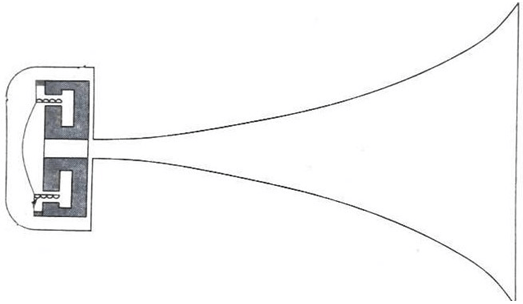This set of Audio Engineering Multiple Choice Questions & Answers (MCQs) focuses on “Characteristics and Types of Loudspeaker – 2”.
1. Which of the following loudspeaker is used to achieve the high power output of more than 25 watts?
a) Horn type
b) Electrodynamic
c) Cone type
d) Carbon
View Answer
Explanation: Basically, to reduce the limitation of moving coil loudspeakers, the electrodynamic loudspeaker was invented. To achieve the high power output of more than 25 watts, we require very strong magnetic field. The working principle of an electrodynamic speaker is same as that of permanent magnet.
2. Frequency response of electrodynamic loudspeaker is not better than moving coil loudspeaker.
a) True
b) False
View Answer
Explanation: The above statement is false. As electrodynamic loudspeaker directly radiates sound energy and is a direct radiating speaker. High power output can be obtained by electrodynamic loudspeaker. Thus, frequency response of electrodynamic loudspeaker is better than moving coil loudspeaker which is 40 Hz to 5 KHz.
3. Identify the construction of loudspeaker from the below figure.

a) Electrodynamic
b) Cone type
c) Horn type
d) Ribbon
View Answer
Explanation: Horn type loudspeaker uses a moving coil placed in a magnetic field (similar to paper cone type). Horn type loudspeaker radiates sound power to the air in space and not directly from the diaphragm but indirectly through the horn. Therefore the horn type loudspeaker is called ‘indirect radiating loudspeaker’.
4. Which type of transformer does horn act in the horn type loudspeaker?
a) Acoustic
b) Grounding
c) Phase-shifting
d) Power
View Answer
Explanation: The horn type loudspeaker is called ‘indirect radiating loudspeaker’. The horn acts an acoustic transformer in horn type loudspeaker. The horn is a tapered enclosure and the efficiency of a horn speaker is quite high.
5. What is the efficiency of a horn type loudspeaker?
a) 5 to 10%
b) 75 to 100%
c) 5 to 7%
d) 30 to 50%
View Answer
Explanation: The horn acts as an acoustic transformer. This allows better impedance match between low impedance of the free air and the high impedance of the vibrating voice coil assembly. This results in increased efficiency. The efficiency of a horn type speaker is 30-50% as against only 5% efficiency of cone type speaker. But the sound produced is not natural.
6. What is the equation of cut off frequency fc of the horn type loud speaker?
a) fc = CA / 2πV
b) fc = DA / 2πV
c) fc = CA / 5πV
d) fc = CA / 3πD
View Answer
Explanation: The exponential horn is a typical circular tube whose cross sectional area increases logarithmically along its length from the throat. The horn acts as a high pass filter. The cutoff frequency fc is given by, fc = CA / 2πV.
Where,
C = Velocity of sound
A = Area of cross-section of throat
V = volume between throat and diaphragm
7. In horn type loudspeakers, the lowest frequency which can be reproduced depends on the diameter of mouth which can be determined by fc = 190 / d.
a) True
b) False
View Answer
Explanation: The above statement is false. In horn type loudspeakers, the lowest frequency which can be reproduced depends on the diameter of mouth which can be determined by fc = 170 / d.
Where,
fc = frequency in Hz
d = diameter of mouth
8. What is the distortion in horn type speaker?
a) 50%
b) 15%
c) 25%
d) Less than 5%
View Answer
Explanation: As the efficiency of horn type loudspeaker is very high, frequency response is generally from 30 Hz to 10 KHz. Horn type loudspeaker uses a moving coil placed in a magnetic field (similar to paper cone type). Thus the distortion in horn type speaker is less than 5%.
9. What is the SNR (Signal to Noise Ratio) of the horn type microphone?
a) 40 dB to 60 dB
b) 4 dB to 6 dB
c) 70 dB to 100 dB
d) 40 dB to 80 dB
View Answer
Explanation: SNR means signal to noise ratio and it is defined as the ratio of output of loudspeaker in the presence of sound to output of loudspeaker in the absence of sound with logarithmic base of 20. Thus, the SNR of the horn type microphone is 40 dB to 60 dB.
Sanfoundry Global Education & Learning Series – Audio Engineering.
To practice all areas of Audio Engineering, here is complete set of 1000+ Multiple Choice Questions and Answers.
If you find a mistake in question / option / answer, kindly take a screenshot and email to [email protected]
